Backend Master | 3.4.5 Deploy - Docker Principal
- 2. Docker Docker ļ×Ć OS Ļ░ĆņāüĒÖö ĻĖ░ņłĀņØĖ ņ╗©ĒģīņØ┤ļäłļź╝ Ļ┤Ćļ”¼ , ņāØņä▒ , ņŗżĒ¢ē , ļ░░ĒżĒĢśĻĖ░ ņ£äĒĢ£ ņśżĒöłņåīņŖż
- 3. ņ╗©ĒģīņØ┤ļäł ŌŚÅ VM Ļ│╝ņØś ņ░©ņØ┤ļź╝ ļŹö ņāüņäĖĒ׳ ņ░ĖĻ│Ā ) /BodenRussell/kvm-and-docker-lxc-benchmarking-with-openstack ņןņĀÉ ļŗ©ņĀÉ ŌŚÅ ļ╣ĀļźĖ ņŗ£ņ×æĻ│╝ ņóģļŻī OS ņ×ģņןņŚÉņä£ļŖö ļŗ©ņł£ĒĢ£ ĒöäļĪ£ņäĖņŖż ņŗżĒ¢ē & ņóģļŻī ŌŚÅ ņśżļ▓äĒŚżļō£Ļ░Ć ļé«ņØī GuestOS Ļ░Ć ņŚåņØ┤ Host OS ņ×ÉņøÉņØä Ļ│Ąņ£ĀĒĢśļ»ĆļĪ£ Ļ░ĆņāüĒÖöņØś ņśżļ▓äĒŚżļō£Ļ░Ć ņĀüņØī ŌŚÅ ņ×ÉņøÉņØś ĒÜ©ņ£©ņĀü ņé¼ņÜ® ņĢĀĒöīļ”¼ņ╝ĆņØ┤ņģś ļÅÖņ×æņŚÉ ĒĢäņÜöĒĢ£ ņ×ÉņøÉņ£╝ļĪ£ ĻĄ¼ņä▒ ŌŚÅ Host OS ņŚÉ ņóģņåŹņĀü ļŗ©ņØ╝ ĒĢśļō£ņø©ņ¢┤ņŚÉ ļŗżņ¢æĒĢ£ OS ņØś ņé¼ņÜ®ņØ┤ ĒĢäņÜöĒĢ£ Ļ▓ĮņÜ░ VM ņØä ņé¼ņÜ®ĒĢ┤ņĢ╝ ĒĢ© . ŌŚÅ Ļ░üĻ░üņØś ņ╗©ĒģīņØ┤ļäłņŚÉ ļÅģļ”ĮļÉ£ ņ╗żļäÉ ĻĄ¼ņä▒ņØ┤ ļČłĻ░ĆļŖźĒĢ© ņ╗żļäÉ ņ×ÉņøÉņØä Ļ│Ąņ£ĀĒĢśĻĖ░ ļĢīļ¼ĖņŚÉ ņ╗©ĒģīņØ┤ļäłĻ░Ć ņé¼ņÜ® ĒĢśļŖö ņ╗żļäÉ ĒÖśĻ▓ĮņØĆ ļÅÖņØ╝ ŌŚÅ Container ļ×Ć ? Ļ▓®ļ”¼ļÉ£ Ļ│ĄĻ░äņŚÉņä£ ĒöäļĪ£ņäĖņŖżĻ░Ć ļÅÖņ×æĒĢśļŖö ĻĖ░ņłĀ .
- 5. Docker ņŚÉņä£ ņé¼ņÜ®ļÉśļŖö ĻĖ░ņłĀ - LXC(LinuX Container), namespaces, cgroup, etc, ...
- 6. Docker ņ╗©ĒģīņØ┤ļäł ņāØņä▒ ļ░Å Ļ┤Ćļ”¼ ŌŚÅ LXC - ņ┤łĻĖ░ Docker ņŚÉņä£ ņé¼ņÜ®ļÉ£ Linux ņÜ® ņ╗©ĒģīņØ┤ļäł Ļ┤Ćļ”¼ ĻĖ░ņłĀ ŌŚÅ libvirt - libvirt ļŖö Ļ░Ćņāüļ©ĖņŗĀņØä ņłśĒ¢ēĒĢśļ®░ Ļ│ĄĒåĄ API ņŚÉ ņĀ£Ļ│ĄĒĢśļŖö ļØ╝ņØ┤ļĖīļ¤¼ļ”¼ņŚÉņä£ ļŗżņ¢æĒĢ£ Ļ░ĆņāüĒÖöļź╝ ņ¦Ć ņøÉĒĢśļ®░ ĻĘĖ ņżæņŚÉņä£ļÅä LXC ļź╝ ņ¦ĆņøÉ ŌŚÅ libcontainer - Docker version 0.9 ņØ┤ĒøäļČĆĒä░ default ļĪ£ ņé¼ņÜ® - Linux Ēöīļ×½ĒÅ╝ņŚÉ ņØśņĪ┤ņĀüņØĖ LXC ļź╝ ļīĆņ▓┤ĒĢśĻĖ░ ņ£äĒĢ┤ Docker ņŚÉņä£ ļ¦īļōĀ ņ╗©ĒģīņØ┤ļäł ĻĖ░ņłĀ Host OS ņØśņĪ┤ņä▒ņØä ņĀ£Ļ▒░ĒĢ┤ ļŗżņ¢æĒĢ£ Ēöīļ×½ĒÅ╝ ņ¦ĆņøÉ (Red Hat, Microsoft Windows, etc) - libcontainer -> runC (libcontainer ņØś ļ”¼Ēī®ĒåĀļ¦ü ĻĄ¼Ēśäņ▓┤ ) ļĪ£ ņ×Éņ▓┤ ĻĄ¼Ēśäņ▓┤ļź╝ Ļ░Ćņ¦É ŌŚÅ Systemd - ņØ╝ļČĆ ļ”¼ļłģņŖż ļ░░ĒżĒīÉņŚÉņä£ ņĄ£ņóģņĀüņ£╝ļĪ£ ļ¬©ļōĀ ĒöäļĪ£ņäĖņŖżļōżņØä Ļ┤Ćļ”¼ĒĢśļŖö init ņŗ£ņŖżĒģ£ . - Systemd ļØ╝ļŖö ņØ┤ļ”ä ļÆżņŚÉ ņČöĻ░ĆļÉ£ ļ¬ģņ╣ŁņØĆ ņ£ĀļŗēņŖżņŚÉņä£ņØś ļŹ░ļ¬¼ņØä ļéśĒāĆļéĖļŗż .
- 7. ļ”¼ļłģņŖż ņ╗©ĒģīņØ┤ļäł (LXC) ŌŚÅ LXC (LinuX Contianer) - chroot Ļ░Ć ĻĖ░ņøÉ (chroot : ņŗ£ņŖżĒģ£ņØä ļ│┤ĒśĖĒĢśĻĖ░ ņ£äĒĢ┤ ĒŖ╣ņĀĢ Ļ▓ĮļĪ£ļź╝ ņĄ£ņāüņ£ä Ļ▓ĮļĪ£ņŚÉ ļ│┤ņØ┤Ļ▓īĒĢ© ) - namespace, cgroup ļź╝ ņé¼ņÜ®ĒĢ┤ ņ╗©ĒģīņØ┤ļäłļź╝ ņāØņä▒ ļ░Å Ļ┤Ćļ”¼ĒĢ©
- 8. LXC vs runC (libcontianer ĻĄ¼Ēśäņ▓┤ )
- 9. Docker Engine, containerd, runc ŌŚÅ Docker Engine -Doker ņØś ņ¦äņ×ģņĀÉ -Docker ņØ┤ļ»Ėņ¦Ć , ņśżņ╝ĆņŖżĒŖĖļĀłņØ┤ņģś , ļ│╝ļź©Ļ┤Ćļ”¼ , ļäżĒŖĖņøīĒé╣ ĒÖĢņן ļō▒ņØä ļŗ┤ļŗ╣ -Docker ņŚöņ¦äņŚÉ ņØ┤ļ»Ėņ¦Ć ņŗżĒ¢ēņØä ņÜöņ▓ŁĒĢśļ®┤ containerd ļŹ░ļ¬¼ņŚÉ ņ▒ģņ×äņØä ņ£äņ×ä ŌŚÅ Containerd - ņ╗©ĒģīņØ┤ļäł ņØ┤ļ»Ėņ¦Ćļź╝ ņĀĆņןĒĢśĻ│Ā ņĀäņåĪ - ļŻ©ĒŖĖ ĒīīņØ╝ņŗ£ņŖżĒģ£ņØä ļ¦īļōżĻ│Ā -runc ĒśĖņČ£ĒĢśņŚ¼ ņ╗©ĒģīņØ┤ļäłļź╝ ņŗ£ņ×æ - ņ╗©ĒģīņØ┤ļäł Ļ┤Ćļ”¼ - ņĀĆņłśņżĆņØś ņŖżĒåĀļ”¼ņ¦ĆņÖĆ ļäżĒŖĖņøīĒü¼ ņØĖĒä░ĒÄśņØ┤ņŖż Ļ┤Ćļ”¼ ŌŚÅ runC - ņ╗©ĒģīņØ┤ļäłņØś ņŗżĒ¢ē ņŗ£ņ×æņØä ļŗ┤ļŗ╣ĒĢśļŖö ĒöäļĪ£ņäĖņŖż . -libcontainer ņØś ļ”¼Ēī®ĒåĀļ¦ü ĻĄ¼Ēśäņ▓┤ .
- 10. ŌŚÅ ĒöäļĪ£ņäĖņŖż ĒģīņØ┤ļĖö ņ╗©ĒģīņØ┤ļäłļ¦łļŗż ļ│äļÅäņØś ĒöäļĪ£ņäĖņŖż ĒģīņØ┤ļĖöņØä Ļ┤Ćļ”¼ ĒŖ╣ņĀĢ ņ╗©ĒģīņØ┤ļäłņØś ĒöäļĪ£ņäĖņŖżņŚÉņä£ ļŗżļźĖ ņ╗©ĒģīņØ┤ļäłņØś ĒöäļĪ£ņäĖņŖżļĪ£ ņĀæĻĘ╝ĒĢĀ ņłś ņŚåņØī ŌŚÅ CPU, ļ®öļ¬©ļ”¼ ņןņ╣ś ( ŌĆ£/devŌĆØ ļŗżņØī ņןņ╣ś ĒīīņØ╝ ) ņ╗©ĒģīņØ┤ļäłņŚÉņä£ ņé¼ņÜ®ĒĢĀ ņłśņ׳ļŖö ļ▓öņ£äļź╝ ņĀ£ĒĢ£ ŌŚÅ ĒīīņØ╝ ņŗ£ņŖżĒģ£ ņ╗©ĒģīņØ┤ļäłļ¦łļŗż ĒŖ╣ņĀĢ ļööļĀēĒåĀļ”¼ļź╝ ļŻ©ĒŖĖ ĒīīņØ╝ ņŗ£ņŖżĒģ£ņ£╝ļĪ£ ļ│┤ņØ┤Ļ▓ī ĒĢ© . ŌŚÅ ļäżĒŖĖņøīĒü¼ ļäżĒŖĖņøīĒü¼ ļäżņ×ä ņŖżĒÄśņØ┤ņŖż (netns) ņØś ĻĖ░ļŖźņ£╝ļĪ£ ņ╗©ĒģīņØ┤ļäłļ¦łļŗż ļ│äļÅäņØś ļäżĒŖĖņøīĒü¼ ņäżņĀĢ ĻĄ¼ņä▒ . veth ļØ╝ļŖö Ļ░Ćņāü NIC ņןņ╣śļź╝ ņØ┤ņÜ®ĒĢśņŚ¼ veth ņØś ĒĢ£ņ¬ĮņØä ņ╗©ĒģīņØ┤ļäł ļé┤ļČĆ ļäżņ×ä ņŖżĒÄśņØ┤ņŖżņŚÉ ĒĢĀļŗ╣ Docker ņ×ÉņøÉņØś Ļ░ĆņāüĒÖö
- 11. Docker ņŚÉņä£ ņé¼ņÜ®ļÉśļŖö ĻĖ░ņłĀ
- 12. ņ╗©ĒģīņØ┤ļäł ĻĄ¼ļČä : namespace namespace ĻĖ░ļŖź PID ļÅģļ”ĮņĀüņØĖ ĒöäļĪ£ņäĖņŖż Ļ│ĄĻ░ä ĒĢĀļŗ╣ Network ļäżĒŖĖņøīĒü¼ ļööļ░öņØ┤ņŖż , IP Address, ĒżĒŖĖ ļ▓łĒśĖ , ļØ╝ņÜ░Ēīģ ĒģīņØ┤ļĖö , ĒĢäĒä░ļ¦ü ĒģīņØ┤ļĖö ļō▒ ļäżĒŖĖņøīĒü¼ ļ”¼ņåīņŖżļź╝ namespace ļ│äļĪ£ ĒĢĀļŗ╣ Ļ░ĆļŖź UID ļÅģļ”ĮņĀüņØĖ ņé¼ņÜ®ņ×É ĒĢĀļŗ╣ User ID(UID) ņÖĆ Group ID(GID) Ļ│ĄĻ░äņØä Ļ▓®ļ”¼ namespace ņÖĖļČĆņŚÉ ņ׳ļŖö user ļéś group ņØ┤ ļé┤ļČĆņØś Ļ│ĄĻ░äņØä ļ│┤Ļ▒░ļéś Ļ▒┤ļō£ļ”┤ ņłś ņŚåņØī Mount ĒīīņØ╝ ņŗ£ņŖżĒģ£ ņČöņāüĒÖöļź╝ ņ£äĒĢ┤ ņé¼ņÜ® ļ¦łņÜ┤ĒŖĖļź╝ ņĪ░ņ×æĒĢśņŚ¼ namespace ļé┤ņŚÉ ĒīīņØ╝ ņŗ£ņŖżĒģ£ ĒŖĖļ”¼ļź╝ ĻĄ¼ņä▒ UTS namespace ļ│äļĪ£ ĒśĖņŖżĒŖĖļ¬ģĻ│╝ ļÅäļ®öņØĖ ļ¬ģņØä ļÅģņ×ÉņĀüņ£╝ļĪ£ Ļ░Ćņ¦ł ņłś ņ׳ņØī IPC Ļ│Ąņ£Ā ļ®öļ¬©ļ”¼ , ĒüÉ , ņäĖļ¦łĒżņ¢┤ ļō▒ ĒöäļĪ£ņäĖņŖż Ļ░äņØś ĒåĄņŗĀ (IPC, Inter-Process Communication) ņ×ÉņøÉņØä ļČäļ”¼ ĒĢĀ ņłś ņ׳ņØī
- 13. ļ”¼ņåīņŖż Ļ┤Ćļ”¼ : cgroup ĒĢŁļ¬® ĻĖ░ļŖź cpu CPU ņé¼ņÜ®ļ¤ē ņĀ£ĒĢ£ cpuacct CPU ņé¼ņÜ®ļ¤ē ĒåĄĻ│ä ņĀĢļ│┤ ņĀ£Ļ│Ą cpuset CPU ņÖĆ ļ®öļ¬©ļ”¼ ļ░░ņ╣ś ņĀ£ņ¢┤ memory ļ®öļ¬©ļ”¼ņÖĆ swap ņé¼ņÜ®ļ¤ē ņĀ£ĒĢ£ devices ļööļ░öņØ┤ņŖż ņŚæņäĖņŖż ĒŚłĻ░Ć ļ░Å ņĀ£ĒĢ£ freezer ĻĘĖļŻ╣ņŚÉ ņåŹĒĢ£ ĒöäļĪ£ņäĖņŖż ņĀĢņ¦Ć ļ░Å ņ×¼Ļ░£ net_cls ļäżĒŖĖņøīĒü¼ ņĀ£ņ¢┤ Ēā£ĻĘĖ ņČöĻ░Ć blkio ļĖöļĪØ ļööļ░öņØ┤ņŖż ņ×ģņČ£ļĀź ļ¤ē ņĀ£ņ¢┤ - ņ╗©ĒģīņØ┤ļäłņŚÉ ĒĢĀļŗ╣ĒĢśļŖö ņ×ÉņøÉņØä ņĪ░ņĀĢĒĢśļŖöļŹ░ ņé¼ņÜ® - ĒöäļĪ£ņäĖņŖż ļ░Å Thread ļź╝ ĻĘĖļŻ╣ĒÖöĒĢśņŚ¼ Ļ┤Ćļ”¼ĒĢśļŖö ĻĖ░ļŖź - Host OS ņØś CPU, ļ®öļ¬©ļ”¼ņÖĆ Ļ░ÖņØĆ ļ”¼ņåīņŖżļź╝ ĻĘĖļŻ╣ļ│äļĪ£ ņĀ£ĒĢ£ Ļ░ĆļŖź -ļŗżņØīĻ│╝ Ļ░ÖņØĆ ņŻ╝ņÜö ņä£ļĖī ņŗ£ņŖżĒģ£ Ļ┤Ćļ”¼ Ļ░ĆļŖź -Ļ│äņĖĄĻĄ¼ņĪ░ļĪ£ ĒöäļĪ£ņäĖņŖżļź╝ ĻĘĖļŻ╣ĒÖöĒĢśņŚ¼ Ļ┤Ćļ”¼Ļ░ĆļŖź -ĒĢśņ£ä cgroup ņØĆ ņāüņ£ä cgroup ņØś ņĀ£ĒĢ£ ņäżņĀĢņØ┤ ĻĘĖļīĆļĪ£ ņĀüņÜ®
- 14. ņØ┤ļ»Ėņ¦Ć ļŹ░ņØ┤Ēä░ Ļ┤Ćļ”¼ : Union File System ŌŚÅ Btrfs Linux ņÜ® Copy on Write ĒīīņØ╝ ņŗ£ņŖżĒģ£ . subvolume ĻĖ░ļŖźĻ│╝ snapshot ĻĖ░ļŖźņØä ņé¼ņÜ®ĒĢśņŚ¼ ņ╗©ĒģīņØ┤ļäł ņØ┤ļ»Ėņ¦ĆņØś ļ│ĆĻ▓ĮņØä ĒīīņØ╝ ņŗ£ņŖżĒģ£ ņĖĄņŚÉņä£ Ļ┤Ćļ”¼ ŌŚÅ AUFS ņä£ļĪ£ ļŗżļźĖ ĒīīņØ╝ ņŗ£ņŖżĒģ£ņØś ĒīīņØ╝Ļ│╝ ļööļĀēĒä░ļ”¼ļź╝ ņżæņ▓®ĒĢśņŚ¼ ĒĢśļéśņØś ĒīīņØ╝ĒŖĖļ”¼ļź╝ ĻĄ¼ņä▒ĒĢĀ ņłś ņ׳ļŖö ĒīīņØ╝ ņŗ£ ņŖżĒģ£ ŌŚÅ Device Mapper Linux ļĖöļĪØ ļööļ░öņØ┤ņŖż ļō£ļØ╝ņØ┤ļ▓äņÖĆ ņØ┤ļź╝ ņ¦ĆņøÉĒĢśļŖö ļØ╝ņØ┤ļĖīļ¤¼ļ”¼ . ĒīīņØ╝ ņŗ£ņŖżĒģ£ņØś ļĖöļĪØ I/O ņÖĆ ļöö ļ░öņØ┤ņŖż ļ¦żĒĢæņØä Ļ┤Ćļ”¼ . Ļ░£ļ│ä ĒīīņØ╝ ņŗ£ņŖżĒģ£ņŚÉ ņØśņĪ┤ĒĢśņ¦Ć ņĢŖņĢä ļŗżņ¢æĒĢ£ ĒÖśĻ▓ĮņŚÉņä£ ņé¼ņÜ® Ļ░ĆļŖź ŌŚÅ overlay Union filesystem ņØś ĒĢśļéśļĪ£ ĒīīņØ╝ ņŗ£ņŖżĒģ£ņŚÉ ļśÉ ļŗżļźĖ ĒīīņØ╝ ņŗ£ņŖżĒģ£ņØä ĒĢ®ņ╣śļŖö ĻĄ¼ņĪ░
- 15. Docker ņØ┤ļ»Ėņ¦Ć ņłśņĀĢ ļ░Å ņŚģļŹ░ņØ┤ĒŖĖ
- 16. Docker Networking ( Ļ░Ćņāü bridge ļ░Å Ļ░Ćņāü NIC) - Docker ņ╗©ĒģīņØ┤ļäłļŖö ņä£ļ▓äņØś ļ¼╝ļ”¼ NIC ņÖĆ ļ│äļÅäļĪ£ Ļ░ü ņ╗©ĒģīņØ┤ļäł ļ¦łļŗż Ļ░Ćņāü NIC ĒĢĀļŗ╣ - Default gateway ļĪ£ Linux bridge ņØĖ docker0 ļź╝ ļ¦īļō” ┬Ę ņÖĖļČĆ ļäżĒŖĖņøīĒü¼ņÖĆ ĻĄÉĒÖśĒĢśļŖö ĒÄśĒéĘņŚÉ NAT ņ×æņŚģ ņłśĒ¢ē ┬Ę ņ╗©ĒģīņØ┤ļäł Ļ░ä ļäżĒŖĖņøīĒü¼ ņŚ░Ļ▓░ - Ļ░ü ņ╗©ĒģīņØ┤ļäłņŚÉ Ļ▓®ļ”¼ļÉ£ ļäżĒŖĖņøīĒü¼ Ļ│ĄĻ░äņØä ļ¦īļōżĻ│Ā ņ╗©ĒģīņØ┤ļäłņØś eth0 ņŚÉ static IP ĒĢĀļŗ╣ - ņ╗©ĒģīņØ┤ļäł ļé┤ļČĆņØś eth0 ņÖĆ docker0 ļĪ£ ņŚ░Ļ▓░ļÉ£ veth ņØĖĒä░ĒÄśņØ┤ņŖżļź╝ ņŚ░Ļ▓░ĒĢ┤ ņ╗©ĒģīņØ┤ļäł ņÖĖļČĆņÖĆ ĒåĄņŗĀ
- 17. ŌŚÅ Docker ņ╗©ĒģīņØ┤ļäłĻ░ä ĒåĄņŗĀ - ļ¦üĒü¼ ĻĖ░ļŖźņØä ņé¼ņÜ®ĒĢ£ ĒåĄņŗĀ ( ļÅÖņØ╝ ĒśĖņŖżĒŖĖņāüņØĖ bridge docker0 ņŚÉ ņĀæņåŹĒĢ£ ņ╗©ĒģīņØ┤ļäłļü╝ļ”¼ļ¦ī Ļ░ĆļŖź ) ŌŚÅ Docker ņ╗©ĒģīņØ┤ļäłņÖĆ ņÖĖļČĆ ļäżĒŖĖņøīĒü¼ ĒåĄņŗĀ - Ļ░Ćņāü bridge docker0 ņÖĆ ĒśĖņŖżĒŖĖ OS ņØś ļ¼╝ļ”¼ NIC ņŚÉņä£ Ēī©ĒéĘņØä ņĀäņåĪ (NAPT ĻĖ░ļŖźņØä ņé¼ņÜ®ĒĢśņŚ¼ ņĀæņåŹ ) Docker Networking (Docker ņ╗©ĒģīņØ┤ļäłĻ░ä ĒåĄņŗĀ )
- 18. Docker Security ŌŚÅ Capability ĒöäļĪ£ņäĖņŖżĻ░Ć Ļ░Ćņ¦ĆļŖö ĻČīĒĢ£ņØä ņäĖļČäĒÖö Ļ┤Ćļ”¼ĒĢśļŖö ĻĖ░ļŖź ņ╗©ĒģīņØ┤ļäł ļé┤ņŚÉņä£ ĒśĖņŖżĒŖĖņŚÉ ņĢģņśüĒ¢źņØä ļ»Ėņ╣śņ¦Ć ņĢŖļÅäļĪØ ņĀ£ņ¢┤ ŌŚÅ SElinux Ļ░ĢņĀ£ ņĢĪņäĖņŖż ņĀ£ņ¢┤ ĻĖ░ļŖź Docker ļŖö ņ╗©ĒģīņØ┤ļäł ņŗ£ņ×æĒĢĀ ļĢī SElinux MCS ļĀłņØ┤ļĖöņØä ņ╗©ĒģīņØ┤ļäłņŚÉ ļČĆņŚ¼ĒĢśĻ│Ā ņ╗©ĒģīņØ┤ļäł ĒöäļĪ£ņäĖ ņŖżņØś ļÅÖņ×æņØä ņ╗©ĒģīņØ┤ļäłļĪ£ ņĀ£ĒĢ£ĒĢ© ŌŚÅ AppArmor Ļ░ĢņĀ£ ņĀæĻĘ╝ ņĀ£ņ¢┤ļź╝ ņ£äĒĢ┤ DTE, RBAC, MLS ļź╝ ņ¦ĆņøÉ ĒāĆ ļ│┤ņĢł ĒöäļĀłņ×äņøīĒü¼ņŚÉ ļ╣äĒĢ┤ ņé¼ņÜ® ļ░Å ņĀĢņ▒ģĻ┤Ćļ”¼Ļ░Ć ĒÄĖļ”¼
- 19. ņ░ĖĻ│Āļ¦üĒü¼ ŌŚÅ [Docker] ņÖäļ▓ĮĒĢ£ IT ņØĖĒöäļØ╝ ĻĄ¼ņČĢņØä ņ£äĒĢ£ Docker: ņĀ£ 2 ņן ņ╗©ĒģīņØ┤ļäł Ļ░ĆņāüĒÖö ĻĖ░ņłĀĻ│╝ Docker ņÜöņĢĮ http://miiingo.tistory.com/88?category=644188 ŌŚÅ Docker(container) ņØś ņ×æļÅÖ ņøÉļ”¼ : namespaces and cgroups https://tech.ssut.me/2017/08/15/what-even-is-a-container/ ŌŚÅ what is Docker? ( Ļ░ĆņāüĒÖö , LXC, ņØ┤ļ»Ėņ¦Ć ) https://kbss27.github.io/2017/04/09/whydocker/ ŌŚÅ Docker Network ĻĄ¼ņĪ░ (1) - docker0 ņÖĆ container network ĻĄ¼ņĪ░ http://bluese05.tistory.com/15 ŌŚÅ Docker Container /rkawkxms/docker-container ŌŚÅ ļÅäņ╗ż ņĢäĒéżĒģŹņ│É ļ░Å ļÅÖņ×æņøÉļ”¼ http://gyus.me/?p=512 ŌŚÅ ļÅäņ╗ż ĻĘĖļ”¼Ļ│Ā Linux ņ╗©ĒģīņØ┤ļäł ĻĖ░ņłĀļōż http://www.opennaru.com/openshift/docker/what-is-the-difference-between-docker-lxd-and-lxc/ ŌŚÅ ļÅäņ╗ż vs LXC ļ╣äĻĄÉ http://wiki.rockplace.co.kr/pages/viewpage.action?pageId=3868344 ŌŚÅ What is Containerd ? https://blog.docker.com/2017/08/what-is-containerd-runtime/ ŌŚÅ What is docker ? https://indrabasak.wordpress.com/2017/04/03/what-is-docker/ ŌŚÅ Docker ņŚÉņä£ ņ¦ĆņøÉĒĢśļŖö Linux Kernel ņØś ĻĖ░ļŖź ( ņÜöņĢĮĒÄĖ ) ’āĀ ņØ╝ļ│Ėņé¼ņØ┤ĒŖĖ http://blog.etsukata.com/2014/05/docker-linux-kernel.html ŌŚÅ docker Ļ░Ć libcontianer ļź╝ ņŗ£ņ×æĒĢ£ ņØ┤ņ£Ā https://www.zdnet.com/article/docker-libcontainer-unifies-linux-container-powers/ ŌŚÅ docker 0.9 : libcontianer ņŗżĒ¢ēļō£ļØ╝ņØ┤ļ▓ä ņåīĻ░£ https://blog.docker.com/2014/03/docker-0-9-introducing-execution-drivers-and-libcontainer/
Editor's Notes
- #3: ļÅäņ╗żļŖö ņ╗©ĒģīņØ┤ļäł Ļ░ĆņāüĒÖö ĒÖśĻ▓ĮņŚÉņä£ ņĢĀĒöīļ”¼ņ╝ĆņØ┤ņģśņØś Ļ┤Ćļ”¼ ļ░Å ņŗżĒ¢ēņØä ņ£äĒĢ£ ņśżĒöł ņåīņŖż Ēöīļ×½ĒÅ╝ņ£╝ļĪ£ ņ£łļÅäņÜ░ ļ░Å ļ”¼ļłģņŖż ņŚÉņä£ ņÜ┤ņśüņ▓┤ņĀ£ ņłśņżĆņØś Ļ░ĆņāüĒÖöļź╝ ņČöņāüĒÖö ĒĢśĻ│Ā ņ×ÉļÅÖĒÖö ĒĢśļŖö ņČöĻ░Ć Ļ│äņĖĄņØä ņĀ£Ļ│ĄĒĢ®ļŗłļŗż.
- #4: Containerļ×Ć Ļ▓®ļ”¼ļÉ£ Ļ│ĄĻ░äņŚÉņä£ ĒöäļĪ£ņäĖņŖżĻ░Ć ļÅÖņ×æĒĢśļŖö ĻĖ░ņłĀ. ĻĖ░ņĪ┤ VMņŚÉņä£ņØś Ļ░ĆņāüĒÖö ļ░®ņŗØņØĆ ņŻ╝ļĪ£ OSļź╝ Ļ░ĆņāüĒÖö ĒĢśļŖö ļ░®ņŗØņØ┤ņśĆļŹś ļ░śļ®┤ņŚÉ containerļŖö Ļ░äļŗ©Ē׳ ļ│┤ļ®┤ filesystemņØś Ļ░ĆņāüĒÖöļ¦īņØä ņØ┤ļŻ©Ļ│Ā ņ׳ņŖĄļŗłļŗż. ĻĖ░ņĪ┤ VMņŚÉņä£ Ļ░üĻ░ü VMļ¦łļŗż Guest OSļź╝ ņäżņ╣śĒĢśņśĆņ¦Ćļ¦ī containerņŚÉņä£ļŖö Guest OSĻ░Ć ĒĢäņÜöņŚåņØ┤ Host OSņØś ņ×ÉņøÉņØä Ļ│Ąņ£ĀĒĢśĻĖ░ ļĢīļ¼ĖņŚÉ Ļ░ĆņāüĒÖöņØś ņśżļ▓äĒŚżļō£Ļ░Ć ņĀüņŖĄļŗłļŗż. ļśÉĒĢ£ containerņŚÉņä£ļŖö ļČĆĒīģ Ļ░£ļģÉņØ┤ ņĪ┤ņ×¼ĒĢśņ¦Ć ņĢŖņĢä ņŗ£ņ×æĻ│╝ ņóģļŻīĻ░Ć ļ╣Āļ”ģļŗłļŗż.
- #5: ļÅäņ╗żļŖö Ēü┤ļØ╝ņØ┤ņ¢ĖĒŖĖ-ņä£ļ▓ä ņĢäĒéżĒģŹņ│Éļź╝ ņé¼ņÜ®ĒĢśļ®░ Ēü┤ļØ╝ņØ┤ņ¢ĖĒŖĖņÖĆ ņä£ļ▓äļŖö ĒśĖņŖżĒŖĖ ļ©ĖņŗĀņŚÉ ņäżņ╣śļÉ£ Docker daemonņ£╝ļĪ£ ļ╣īļō£ņÖĆ ņŗżĒ¢ē, ļ░░Ēżļō▒ņØä ĒĢĀ ņłś ņ׳ļÅäļĪØ ĒåĄņŗĀĒĢ®ļŗłļŗż. ŌŚÅ ļÅäņ╗żņØś ļÅÖņ×æ ļ░®ņŗØ ņ¢┤Ēöīļ”¼ņ╝ĆņØ┤ņģśņØä ļŗ┤ĻĖ░ ņ£äĒĢ┤ ļÅäņ╗ż ņØ┤ļ»Ėņ¦Ćļź╝ ļ╣īļō£ĒĢśĻ│Ā,ļÅäņ╗ż ņØ┤ļ»Ėņ¦ĆļĪ£ ļČĆĒä░ ņ¢┤Ēöīļ”¼ņ╝ĆņØ┤ņģśņØä ņŗżĒ¢ēĒĢśĻĖ░ ņ£äĒĢ£ ļÅäņ╗ż ņ╗©ĒģīņØ┤ļäłļź╝ ļ¦īļōżļ®░ ļÅäņ╗żņØś ņØ┤ļ»Ėņ¦ĆļŖö Ļ│ĄĻ░£/ņé¼ņäż ņĀĆņןņåīņŚÉņä£ Ļ│Ąņ£ĀĒĢĀ ņłś ņ׳ņŖĄļŗłļŗż. -------------------------------------------- ŌŚÅ DOCKER IMAGES ļÅäņ╗ż ņØ┤ļ»Ėņ¦ĆļŖö ņØĮĻĖ░ņĀäņÜ® Ēģ£Ēöīļ”┐ņØ┤ļŗż. ņśłļź╝ļōżļ®┤, ņÜ░ļČäĒł¼ņŚÉ ņĢäĒīīņ╣ś ņø╣ņä£ļ▓äļź╝ ņäżņ╣śĒĢ£ Ļ▓āņØä ĒĢśļéśņØś ņØ┤ļ»Ėņ¦ĆļØ╝Ļ│Ā ļ│╝ ņłś ņ׳ļŗż.ļÅäņ╗ż ņØ┤ļ»Ėņ¦ĆļŖö ļÅäņ╗ż ņ╗©ĒģīņØ┤ļäłļź╝ ļ¦īļō£ļŖöļŹ░ ņé¼ņÜ®ļÉśĻ│Ā, ļÅäņ╗żļŖö ņāłļĪ£ņÜ┤ ņØ┤ļ»Ėņ¦Ćļź╝ ļ╣īļō£ĒĢĀ ņłś ņ׳ļŖö ņŗ¼ĒöīĒĢ£ ļ░®ļ▓ĢņØä ņĀ£Ļ│ĄĒĢ£ļŗż. Ēś╣ņØĆ ļŗżļźĖ ņé¼ļ×īņØ┤ ļ¦īļōĀĻ▓āņØä ļŗżņÜ┤ļ░øņØä ņłśļÅä ņ׳ļŗż. ņØ┤ļ»Ėņ¦ĆļŖö ļÅäņ╗żņØś╠²ļ╣īļō£╠²ņ╗┤ĒżļäīĒŖĖņØ┤ļŗż. ŌŚÅ DOCKER REGISTRIES ļÅäņ╗ż ļĀłņ¦ĆņŖżĒŖĖļ”¼ļŖö ņØ┤ļ»Ėņ¦ĆļōżņØä ļ│┤Ļ┤ĆĒĢśļŖö Ļ││ņØ┤ļŗż. ņØ┤ļ»Ėņ¦Ćļź╝ ņŚģļĪ£ļō£/ļŗżņÜ┤ļĪ£ļō£ ĒĢĀ ņłś ņ׳ļŖö Ļ│ĄĻ░£ ņĀĆņןņåīņÖĆ ņé¼ņäż ņĀĆņןņåīĻ░Ć ņ׳ļŗż. Ļ│ĄĻ░£ ņĀĆņןņåīļŖö Docker hubņŚÉņä£ ņĀ£Ļ│ĄļÉśĻ│Ā ņ׳ļŗż.ļÅäņ╗ż ļĀłņ¦ĆņŖżĒŖĖļ”¼ļŖö ļÅäņ╗żņØś╠²ļ░░Ēż╠²ņ╗┤ĒżļäīĒŖĖņØ┤ļŗż. ŌŚÅ DOCKER CONTAINERS ļÅäņ╗ż ņ╗©ĒģīņØ┤ļäłļŖö ļööļĀēĒåĀļ”¼ņÖĆ ļ╣äņŖĘĒĢśļŗż. ļÅäņ╗ż ņ╗©ĒģīņØ┤ļäłļŖö ņ¢┤Ēöīļ”¼ņ╝ĆņØ┤ņģśņØä ņŗżĒ¢ēĒĢśĻĖ░ ņ£äĒĢ£ ļ¬©ļōĀĻ▓āņØä Ļ░Ćņ¦ĆĻ│Ā ņ׳ļŗż. Ļ░üĻ░üņØś ņ╗©ĒģīņØ┤ļäłļŖö ĒĢśļéśņØś ļÅäņ╗ż ņØ┤ļ»Ėņ¦ĆļĪ£ ļ¦īļōżņ¢┤ ņ¦äļŗż.ļÅäņ╗ż ņ╗©ĒģīņØ┤ļäłļŖö ņŗżĒ¢ēļÉĀņłś ņ׳Ļ│Ā, ņŗ£ņ×æ ņŗ£Ēé¼ ņłś ņ׳Ļ│Ā, ņżæņ¦Ć ņŗ£Ēé¼ ņłś ņ׳Ļ│Ā, ņØ┤ļÅÖ ņŗ£Ēé¼ ņłś ņ׳Ļ│Ā, ņéŁņĀ£ ĒĢĀ ņłś ņ׳ļŗż. Ļ░üĻ░üņØś ņ╗©ĒģīņØ┤ļäłļŖö Ļ│Āļ”ĮļÉśņ¢┤ ņ׳ņ¢┤ļ®░ ņĢłņĀäĒĢ£ ņ¢┤Ēöīļ”¼ņ╝ĆņØ┤ņģś Ēöīļ×½ĒÅ╝ņØ┤ļŗż.ļÅäņ╗ż ņ╗©ĒģīņØ┤ļäłļŖö ļÅäņ╗żņØś╠²ņŗżĒ¢ē╠²ņ╗┤ĒżļäīĒŖĖņØ┤ļŗż.
- #6: DockerļŖö ņ╗©ĒģīņØ┤ļäłļź╝ Ļ┤Ćļ”¼ĒĢśĻĖ░ ņ£äĒĢśņŚ¼ libvirt, LXC ļ░Å systemd-nspawnņØä ĒåĄĒĢ┤ ņČöņāüĒÖöļÉ£ Ļ░ĆņāüĒÖö ņØĖĒä░ĒÄśņØ┤ņŖżļź╝ ņé¼ņÜ®ĒĢśļ®░ ļ”¼ļłģņŖżņŚÉņä£ ņĀ£Ļ│ĄĒĢśļŖö Ļ░ĆņāüĒÖö ĻĖ░ļŖź ņÖĖņŚÉ ņ×Éņ▓┤ņĀüņ£╝ļĪ£ libcontainer ļØ╝ņØ┤ļĖīļ¤¼ļ”¼ļź╝ ĒżĒĢ©ĒĢ®ļŗłļŗż. ļśÉĒĢ£, cgroups ļ░Å namespacesņÖĆ Ļ░ÖņØĆ Linux ņ╗żļäÉņØś ļ”¼ņåīņŖż Ļ▓®ļ”¼ĻĖ░ļŖźĻ│╝ Union ĒīīņØ╝ ņŗ£ņŖżĒģ£ņØä ņé¼ņÜ®ĒĢśņŚ¼ ļÅģļ”ĮņĀüņØĖ ņ╗©ĒģīņØ┤ļäłļź╝ ņŗżĒ¢ēĒĢśĻ│Ā ņ£Āņ¦Ć Ļ┤Ćļ”¼ĒĢĀ ņłś ņ׳ņŖĄļŗłļŗż.
- #7: ļÅäņ╗żļŖö╠²libvirt,╠²LXC╠²(ļ”¼ļłģņŖż ņ╗©ĒģīņØ┤ļäł),╠²systemd-nspawnņØä ĒåĄĒĢ£ ņČöņāüĒÖöļÉ£ Ļ░ĆņāüĒÖö ņØĖĒä░ĒÄśņØ┤ņŖżļź╝ ņé¼ņÜ®ĒĢśļŖö Ļ▓ā ļ┐É ņĢäļŗłļØ╝ ļ”¼ļłģņŖż ņ╗żļäÉņØ┤ ņĀ£Ļ│ĄĒĢśļŖö Ļ░ĆņāüĒÖö ĻĖ░ļŖźņØä ņ¦üņĀæ ņé¼ņÜ®ĒĢśĻĖ░ ņ£äĒĢ£ ņ×Éņ▓┤ņĀüņØĖ ņłśļŗ©ņ£╝ļĪ£╠²libcontainer╠²ļØ╝ņØ┤ļĖīļ¤¼ļ”¼ļź╝ ĒżĒĢ©ĒĢśĻ│Ā ņ׳ņŖĄļŗłļŗż ļÅäņ╗żļŖö ņØ┤ ĻĖ░ņłĀļōżņØä ņé¼ņÜ®ĒĢśņŚ¼ ļÅäņ╗żļŖö Ļ░äņĀæņĀüņ£╝ļĪ£ ļ”¼ļłģņŖż ņ╗żļäÉņØś Ļ░ĆņāüĒÖö ĻĖ░ļŖźļōżņŚÉ ņĀæĻĘ╝ĒĢśļ®░ Ēśäņ×¼ default Ēżļ¦ĘņØĆ╠²libcontainerņ×ģļŗłļŗż.
- #8: ļ”¼ļłģņŖż ņ╗©ĒģīņØ┤ļäłņØś ĻĖ░ņøÉņØĆ chrootļØ╝Ļ│Ā ĒĢĀ ņłś ņ׳ņŖĄļŗłļŗż. Ļ│╝Ļ▒░ņŚÉļŖö chroot ļ¬ģļĀ╣ņ¢┤ļĪ£ ņ╗©ĒģīņØ┤ļäłļź╝ ņāØņä▒ĒĢśņśĆļŖöļŹ░, chrootļŖö ĒīīņØ╝ņŗ£ņŖżĒģ£ņŚÉņä£ ļŻ©ĒŖĖ ļööļĀēĒä░ļ”¼ļź╝ ļ│ĆĻ▓ĮĒĢśļŖö ļ¬ģļĀ╣ņ¢┤ļĪ£ ĒŖ╣ņĀĢ ļööļĀēĒä░ļ”¼ļź╝ ļŻ©ĒŖĖ ļööļĀēĒä░ļ”¼ļĪ£ ņäżņĀĢĒĢśļ®┤ chroot jailņØ┤ļØ╝ļŖö ĒÖśĻ▓ĮņØ┤ ņāØņä▒ļÉśņä£ chroot jailņĢłņŚÉņä£ļŖö ļ░öĻ╣źņØś ĒīīņØ╝Ļ│╝ ļööļĀēĒä░ļ”¼ņŚÉ ņĀæĻĘ╝ ĒĢĀ ņłś ņŚåņŖĄļŗłļŗż. ņØ┤ņ▓śļ¤╝ chrootļŖö ļööļĀēĒä░ļ”¼ Ļ▓ĮļĪ£ļź╝ Ļ▓®ļ”¼ĒĢśĻĖ░ ļĢīļ¼ĖņŚÉ ņä£ļ▓ä ņĀĢļ│┤ ņ£ĀņČ£Ļ│╝ Ēö╝ĒĢ┤ļź╝ ņĄ£ņåīĒÖöĒĢśļŖöļŹ░ ņŻ╝ļĪ£ ņé¼ņÜ®ļÉśņŚłņŖĄļŗłļŗż. ĒĢśņ¦Ćļ¦ī chroot jailņŚÉ ļōżņ¢┤Ļ░ł ņŗżĒ¢ē ĒīīņØ╝Ļ│╝ Ļ│Ąņ£Ā ļØ╝ņØ┤ļĖīļ¤¼ļ”¼ļź╝ ņ¦üņĀæ ņżĆļ╣äĒĢ┤ņĢ╝ Ē¢łĻ│Ā ņäżņĀĢņØ┤ ļ│Ąņ×ĪĒĢśļ®░ ņÖäļ▓ĮĒĢ£ Ļ░Ćņāü ĒÖśĻ▓ĮņØ┤ ņĢäļŗłĻĖ░ ļĢīļ¼ĖņŚÉ chrootņŚÉņä£ ņĀ£ņ¢┤ ĒĢĀ ņłś ņ׳ļŖö ĒīīņØ╝ņØ┤ļéś ļööļĀēĒåĀļ”¼ņŚÉ ļīĆĒĢ£ ņŚæņäĖņŖżļ¦īņ£╝ļĪ£ ļäżĒŖĖņøīĒü¼ ļ░Å ĒöäļĪ£ņäĖņŖż ļō▒ņØä ņ╗©ĒŖĖļĪż ĒĢĀ ņłś ņŚåņŖĄļŗłļŗż. ņØ┤Ēøä ļ”¼ļłģņŖżļŖö chrootļź╝ ļ░£ņĀäņŗ£ņ╝£ ļ”¼ļłģņŖż ņ╗©ĒģīņØ┤ļäłļØ╝ļŖö ņŗ£ņŖżĒģ£ ļĀłļ▓© Ļ░ĆņāüĒÖöļź╝ ņĀ£Ļ│ĄĒ¢łņŖĄļŗłļŗż.╠² NamespacesņŚÉņä£ ņĀ£Ļ│ĄĒĢśļŖö ĒöäļĪ£ņäĖņŖż ĒŖĖļ”¼, ņé¼ņÜ®ņ×É Ļ│äņĀĢ, ĒīīņØ╝ņŗ£ņŖżĒģ£, IPC, ļäżĒŖĖņøīĒü¼ ņןņ╣ś ļō▒ņØś ņÜ┤ņśüĒÖśĻ▓ĮņØä Ļ│Āļ”Įņŗ£ņ╝░ņ£╝ļ®░ cgroupsļź╝ ĒåĄĒĢ┤ Ļ░üĻ░üņØś Ļ│Āļ”ĮļÉ£ ĒÖśĻ▓ĮņŚÉ cpu, memory, disk, networkņÖĆ Ļ░ÖņØĆ ņ×ÉņøÉņØä ĒĢĀļŗ╣ĒĢ®ļŗłļŗż. ņØ┤ļ¤¼ĒĢ£ ļ░®ņŗØņ£╝ļĪ£ LXCļŖö Ļ▓®ļ”¼ļÉ£ ņ╗©ĒģīņØ┤ļäłļź╝ ņāØņä▒ĒĢśĻ│Ā ņĀ£Ļ│ĄĒ¢łņŖĄļŗłļŗż. ņé¼ņŗż ņ╗©ĒģīņØ┤ļäłļ¦ī ĒĢäņÜöĒĢśļŗżļ®┤ LXCļ¦ī ņé¼ņÜ®ĒĢ┤ļÅä ļÉśņ¦Ćļ¦ī LXCļŖö ņ╗©ĒģīņØ┤ļäłņØś ņāØņä▒ ļ░Å Ļ┤Ćļ”¼, ļ░░ĒżņŚÉ ļīĆĒĢ£ ļČĆĻ░Ć ĻĖ░ļŖźņØ┤ ņŚåĻĖ░ ļĢīļ¼ĖņŚÉ ņŗżņĀ£ ņä£ļ╣äņŖżļź╝ ņÜ┤ņÜ®ĒĢśĻĖ░ņŚÉļŖö ļČĆņĪ▒ĒĢ©ņØ┤ ņ׳ņŖĄļŗłļŗż. DockerļŖö ņØ┤ļź╝ ļ│┤ņČ®ĒĢśņŚ¼ ņ╗©ĒģīņØ┤ļäłņŚÉ ļīĆĒĢ£ ļČĆĻ░Ć ĻĖ░ļŖźņØä ņĀ£Ļ│ĄĒĢśĻ│Ā ņ╗©ĒģīņØ┤ļäłņØś ņāüĒā£ļź╝ ņØ┤ļ»Ėņ¦ĆĒÖöĒĢśņŚ¼ ļ░░Ēżļź╝ ņåÉņēĮĻ▓ī ĒĢ┤ņŻ╝ņŚłņŖĄļŗłļŗż.
- #9: ĻĖ░ņĪ┤ņØś ņ╗©ĒģīņØ┤ļäłļŖö Ļ░üĻ░üņØś OS ļé┤ņŚÉņä£ ņ×æļÅÖĒĢśļŖö Ļ▓Įļ¤ēĒÖöļÉ£ VMņØś ĻĄ¼ĒśäņØ┤ļØ╝ļŖö ļ¬®ņĀüņØ┤ņŚłļŗżļ®┤╠² DockerļŖö Ļ░£ļ░£ņ×ÉļōżņØ┤ ļŗżņ¢æĒĢ£ OSņŚÉņä£ ņ×æļÅÖĒĢśļŖö ļÅÖņØ╝ĒĢ£ Ļ░£ļ░£ĒÖśĻ▓ĮņØä ĻĄ¼ĒśäĒĢśļŖö Ļ▓āņØä ļ¬®ņĀüņ£╝ļĪ£ ļ¦īļōżņ¢┤ņĪīņŖĄļŗłļŗż. (ņØ┤ņĀä ĒÄśņØ┤ņ¦ĆņŚÉņä£ņ▓śļ¤╝) Docker ĒöäļĪ£ņĀØĒŖĖ ņ┤łĻĖ░ņŚÉļŖö LXCĻ░Ć ļäżņ×ä ņŖżĒÄśņØ┤ņŖż, cgroup, ĻĖ░ļŖź ļō▒Ļ│╝ Ļ░ÖņØĆ ņØ╝ļČĆ ņ╗żļäÉ ĻĖ░ļŖźņŚÉ ļīĆĒĢ£ ņØĖĒä░ĒÄśņØ┤ņŖżņÖĆ Ļ░ÖņØ┤ ĻĖ░ļ│Ė ņŗżĒ¢ē ļō£ļØ╝ņØ┤ļ▓äļĪ£ ņé¼ņÜ®ļÉśļ®░ Linux ņé¼ņÜ®ņ×ÉĻ░Ć ņŗ£ņŖżĒģ£ ļśÉļŖö ņØæņÜ® ĒöäļĪ£ĻĘĖļש ņ╗©ĒģīņØ┤ļäłļź╝ ņēĮĻ▓ī ļ¦īļōżĻ│Ā Ļ┤Ćļ”¼ ĒĢĀ ņłś ŌĆŗŌĆŗņ׳ņŚłņŖĄļŗłļŗż. ĒĢśņ¦Ćļ¦ī ņØśņĪ┤ņä▒ņ£╝ļĪ£ ņØĖĒĢ┤ ļ¼ĖņĀ£ļź╝ ļ░£ņāØ ņŗ£ņ╝░Ļ│Ā DockerņØś ĒĢĄņŗ¼ ĻĖ░ļŖźņØ┤ņśĆļŹś LXC Ļ░£ļ░£ņØä ņĀ£ņ¢┤ ĒĢĀ ņłś ņŚåņ¢┤ ņāłļĪ£ņÜ┤ ņśżĒöł ņåīņŖż ņŗżĒ¢ē ļō£ļØ╝ņØ┤ļ▓ä ņØĖ libcontainerĻ░Ć ļ¦īļōżņ¢┤ņĪīņŖĄļŗłļŗż. Docker ņŚÉņä£ LXCļź╝ ņé¼ņÜ®ĒĢśļŖö ņ╗©ĒģīņØ┤ļäłņØś Ēæ£ņżĆ ļ¤░ĒāĆņ×ä ĒÖśĻ▓Įņ£╝ļĪ£ ņĀ£Ļ│ĄĒĢśņ¦Ćļ¦ī defaultļĪ£ libcontainerņÖĆ ĒĢ©Ļ╗ś ņĀ£Ļ│ĄļÉ®ļŗłļŗż. libcontainer╠²ļŖö╠²ļŗżļźĖ ņØśņĪ┤ņä▒ ņŚåņØ┤ ņ╗żļäÉņØś ņ╗©ĒģīņØ┤ļäł APIņŚÉ ņ¦üņĀæ ņĢĪņäĖņŖżĒĢśĻĖ░ ņ£äĒĢ┤ Ļ░£ļ░£ ļÉ£ ļØ╝ņØ┤ļĖīļ¤¼ļ”¼ņ×ģļŗłļŗż. libcontainer ļź╝ ņé¼ņÜ®ĒĢśļ®┤ LXC ļéś ļŗżļźĖ ņé¼ņÜ®ņ×É ņśüņŚŁ Ēī©Ēéżņ¦ĆņŚÉ ņØśņĪ┤ĒĢśņ¦Ć ņĢŖĻ│ĀļÅä ņ”ēņŗ£ ļäżņ×ä ņŖżĒÄśņØ┤ņŖż, ņĀ£ņ¢┤ ĻĘĖļŻ╣, ĻĖ░ļŖź, ļäżĒŖĖņøīĒü¼ ņØĖĒä░ĒÄśņØ┤ņŖż ļ░Å ļ░®ĒÖöļ▓Į ĻĘ£ņ╣ÖņØä ņØ╝Ļ┤ĆļÉśĻ▓ī ņé¼ņÜ® ĒĢĀ ņłś ņ׳Ļ│Ā ņśłņĖĪ Ļ░ĆļŖźĒĢ£ ļ░®ņŗØņ£╝ļĪ£ ņĪ░ņ×æ ĒĢĀ ņłś ņ׳ņ£╝ļ®░,╠²LXC ņ▓śļ¤╝ ļ▓äņĀä ļ░Å ļ░░ĒżĒīÉĻ│╝ Ļ┤ĆļĀ©ļÉ£ ļ¼ĖņĀ£ņŚÉ ņśüĒ¢źņØä ļ░øņ¦Ć ņĢŖņŖĄļŗłļŗż. ĻĘĖļ”¼Ļ│Ā libcontianerļŖö ņŗ£Ļ░äņØ┤ ņ¦Ćļé©ņŚÉ ļö░ļØ╝ ļŹö Ēü░ ņśżĒöł ņåīņŖż ņāØĒā£Ļ│äņÖĆ ņé░ņŚģ Ēæ£ņżĆņØä ņżĆņłśĒĢśĻĖ░ ņ£äĒĢ┤ ņŚ¼ļ¤¼ ņČöņāüĒÖö ļĀłņØ┤ņ¢┤ļź╝ ņČöĻ░ĆĒĢśļ®┤ņä£ ņČöĒøä runC ĻĖ░ņłĀļĪ£ ĒĢ®ņ│ÉņĪīņŖĄļŗłļŗż. Ēśäņ×¼ Docker ņŚöņ¦äņØś ņŻ╝ņÜö ĻĄ¼ņä▒ ņÜöņåīļŖö containerd ļ░Å runCņ×ģļŗłļŗż.
- #10: ļÅäņ╗żļŖö LXCļź╝ ĻĖ░ļ░śņ£╝ļĪ£ ņŗ£ņ×æĒĢ┤ņä£ 0.9ļ▓äņĀäņŚÉņä£ ņ×Éņ▓┤ņĀüņØĖ╠²libcontainer╠²ĻĖ░ņłĀņØä ņé¼ņÜ®ĒĢśņśĆĻ│Ā ņČöĒøä╠²runCĻĖ░ņłĀļĪ£ ĒĢ®ņ│ÉņĪīņŖĄļŗłļŗż. runC ņÖĆ containerdļź╝ ĻĖ░ļ░śņ£╝ļĪ£ ĒĢ£ Docker 1.11ņØ┤ ņ▓śņØī ņČ£ņŗ£ļÉśņŚłĻ│Ā ņØ┤Ēøä Docker ļŖö Kubernetes(ņ┐Āļ▓äļäżĒŗ░ņŖż)ņÖĆ Ļ░ÖņØĆ ņ╗©ĒģīņØ┤ļäł Ēöīļ×½ĒÅ╝ņØś ņÜöĻĄ¼ņÖĆ ļÅÖļō▒ĒĢ£ ņłśņżĆĻ╣īņ¦Ć ļüīņ¢┤ ņś¼ ņłś ņ׳ļŖö ļ¦ÄņØĆ ĻĖ░ļŖźņØ┤ ņČöĻ░ĆļÉśņŚłņŖĄļŗłļŗż. docker ņŚöņ¦äņØĆ DockerņØś ņŻ╝ņÜö ņ¦äņ×ģ ņĀÉņ£╝ļĪ£ Docker ņØ┤ļ»Ėņ¦Ć, ņśżņ╝ĆņŖżĒŖĖļĀłņØ┤ņģś, ļ│╝ļź© Ļ┤Ćļ”¼, ļäżĒŖĖņøīĒé╣, ĒÖĢņן ļō▒ņØä ļŗ┤ļŗ╣ĒĢ®ļŗłļŗż. Docker Command Line (CL)ņŚÉņä£ Docker EngineņŚÉ ņØ┤ļ»Ėņ¦Ć ņŗżĒ¢ēņØä ņÜöņ▓ŁĒĢśļ®┤, Docker EngineņØĆ ĒĢ┤ļŗ╣ ņ▒ģņ×äņØä containerd ļŹ░ļ¬¼ņŚÉ ņ£äņ×äĒĢ®ļŗłļŗż. containerdļŖö ņ╗©ĒģīņØ┤ļäł ņØ┤ļ»Ėņ¦Ćļź╝ ņĀĆņןĒĢśĻ│Ā ņĀäņåĪĒĢśļŖö Ļ▓āņØä ļŗ┤ļŗ╣ĒĢśļ®░ ļŻ©ĒŖĖ ĒīīņØ╝ ņŗ£ņŖżĒģ£ņØä ļ¦īļōżĻ│Ā containerd-shimņØä ĒåĄĒĢ┤ runCļź╝ ĒśĖņČ£ĒĢśņŚ¼ ņ╗©ĒģīņØ┤ļäłļź╝ ņŗ£ņ×æĒĢśĻ│Ā, ņ╗©ĒģīņØ┤ļäłļź╝ Ļ░ÉļÅģĒĢ®ļŗłļŗż. ļśÉĒĢ£ ņĀĆņłśņżĆņØś ņŖżĒåĀļ”¼ņ¦Ć ļ░Å ļäżĒŖĖņøīĒü¼ ņØĖĒä░ĒÄśņØ┤ņŖżļź╝ Ļ┤Ćļ”¼ĒĢ®ļŗłļŗż. containerd-shim : ņ╗©ĒģīņØ┤ļäł ĒöäļĪ£ņäĖņŖżņØś ļČĆļ¬© *OCI ņśżĒöł ņ╗©ĒģīņØ┤ļäł ĒöäļĪ£ņĀØĒŖĖ(OCP)ļØ╝ļŖö Ļ│äĒÜŹņØ┤ ļ░£Ēæ£ļÉśņŚłĻ│Ā ļéśņżæņŚÉ ņśżĒöł ņ╗©ĒģīņØ┤ļäł Ļ│äĒÜŹ(OCI)ņØ┤ļØ╝ļŖö ņØ┤ļ”äņ£╝ļĪ£ ļ░öļĆīņŚłļŗż. ļ”¼ļłģņŖż ņ×¼ļŗ©ņØś ĒøäņøÉņ£╝ļĪ£ ņÜ┤ņśüļÉśļŖö OCIņØś ļ¬®ņĀüņØĆ ņ╗©ĒģīņØ┤ļäł ĒśĢņŗØņØś ņŚģĻ│ä Ēæ£ņżĆĻ│╝ ļ¬©ļōĀ Ēöīļ×½ĒÅ╝ņŚÉ ļīĆĒĢ£ ņ╗©ĒģīņØ┤ļäł ļ¤░ĒāĆņ×ä ņåīĒöäĒŖĖņø©ņ¢┤ļź╝ Ļ░£ļ░£ĒĢśļŖö Ļ▓āņØ┤ļŗż.ņøÉļ¼Ėļ│┤ĻĖ░:╠²http://www.ciokorea.com/news/34694#csidx4daa22a1f377731bb8709aede46da5f╠²
- #11: ņ╗©ĒģīņØ┤ļäłļ¦łļŗż ļČäĒĢĀļÉśļŖö ņ×ÉņøÉņŚÉļŖö ļŗżņØīĻ│╝ Ļ░ÖņØĆ Ļ▓āņØ┤ ņ׳ņŖĄļŗłļŗż. ņ╗©ĒģīņØ┤ļäłļ¦łļŗż ļ│äļÅäņØś ĒöäļĪ£ņäĖņŖż ĒģīņØ┤ļĖöņØä Ļ┤Ćļ”¼ĒĢśņŚ¼ ņ╗©ĒģīņØ┤ļäłņØś ĒöäļĪ£ņäĖņŖżņŚÉņä£ ļŗżļźĖ ņ╗©ĒģīņØ┤ļäłņØś ĒöäļĪ£ņäĖņŖżĻ░Ć ļ│┤ņØ┤ņ¦Ć ņĢŖļÅäļĪØ ĒĢśļ®░,cgroupsņØś ĻĖ░ļŖźņØä ĒåĄĒĢ┤ ņ╗©ĒģīņØ┤ļäłņŚÉņä£ ņé¼ņÜ®ĒĢĀ ņłś ņ׳ļŖö ļ▓öņ£äļź╝ ņĀ£ĒĢ£ĒĢ®ļŗłļŗż ņ╗©ĒģīņØ┤ļäłļ¦łļŗż ĒŖ╣ņĀĢ ļööļĀēĒåĀļ”¼ļź╝ ļŻ©ĒŖĖ ĒīīņØ╝ ņŗ£ņŖżĒģ£ņ£╝ļĪ£ ļ│┤ņØ┤Ļ▓ī ĒĢ®ļŗłļŗż. ņØ┤ļŖö ŌĆ£chrootŌĆØņÖĆ ļÅÖņØ╝ĒĢ£ Ļ░£ļģÉņ×ģļŗłļŗż. ļäżĒŖĖņøīĒü¼ ļäżņ×ä ņŖżĒÄśņØ┤ņŖż (netns)ņØś ĻĖ░ļŖźņØĆ ņ╗©ĒģīņØ┤ļäłļ¦łļŗż ļ│äļÅäņØś ļäżĒŖĖņøīĒü¼ ņäżņĀĢņØä ĻĄ¼ņä▒ĒĢ®ļŗłļŗż.
- #12: DockerņŚÉņä£ ņé¼ņÜ®ļÉśļŖö Linux KernelņØś ĻĖ░ļŖźņØĆ ļŗżņØīĻ│╝ Ļ░ÖņŖĄļŗłļŗż. Ļ░ü ĻĖ░ļŖźņØĆ Ēü¼Ļ▓ī,╠²Namespaces╠²,╠²Cgroups╠²,╠²Storage╠²,╠²Networking╠²,╠²Security╠²ļĪ£ ļéśļłī ņłś ņ׳ņŖĄļŗłļŗż.╠²
- #13: Namespaceļ×Ć ņ¢┤ļ¢ż namespaceņŚÉ ņåŹĒĢśļŖÉļāÉņŚÉ ļö░ļØ╝ ņä£ļĪ£ ļŗżļźĖ ņĪ┤ņ×¼ļĪ£ ņØĖņŗØļÉ©ņ£╝ļĪ£ņŹ© Ļ░ü ļĀłņØ┤ņ¢┤ļź╝ Ļ▓®ļ”¼ĒĢśļŖö ĻĖ░ņłĀļĪ£ ĒĢ£ Ļ││ņŚÉ ĒĢ®ņ│Éņ¦ä ļŹ░ņØ┤Ēä░ņŚÉ ņØ┤ļ”äņØä ļČÖņŚ¼ ņČ®ļÅī Ļ░ĆļŖźņä▒ņØä ļé«ņČöĻ│Ā ņēĮĻ▓ī ņ░ĖņĪ░ĒĢĀ ņłś ņ׳ļÅäļĪØ ĒĢśļŖö ĻĖ░ļŖźņØä ņĀ£Ļ│ĄĒĢ®ļŗłļŗż. dockerļŖö ņØ┤ļ¤░ namespaces ĻĖ░ļŖź ņé¼ņÜ®ĒĢśļ®░, ņ╗©ĒģīņØ┤ļäłļź╝ ņŗżĒ¢ēĒĢśĻ▓ī ļÉśļ®┤ ĒĢ┤ļŗ╣ ņ╗©ĒģīņØ┤ļäłņØś namesapceļź╝ ņāØņä▒ĒĢśņŚ¼ ņ╗©ĒģīņØ┤ļäłļź╝ Ļ▓®ļ”¼ĒĢ®ļŗłļŗż. ļÅäņ╗żĻ░Ć ņé¼ņÜ®ĒĢśļŖö namespaceļŖö ļŗżņØīĻ│╝ Ļ░ÖņŖĄļŗłļŗż. - PID : ĒöäļĪ£ņäĖņŖż Ļ▓®ļ”¼ņŚÉ ņé¼ņÜ® - NET : ļäżĒŖĖņøīĒü¼ņØĖĒä░ĒÄśņØ┤ņŖż Ļ┤Ćļ”¼ņŚÉ ņé¼ņÜ® - UID : ļÅģļ”ĮņĀüņØĖ ņé¼ņÜ®ņ×É ĒĢĀļŗ╣ - UTS : ļÅģļ”ĮņĀüņØĖ hostname ĒĢĀļŗ╣ĒĢśļ®░ ņ╗żļäÉ Ļ▓®ļ”¼ņÖĆ ļ▓äņĀä ņØĖņŗØņŚÉ ņé¼ņÜ® (UTS : Unix Timesharing System) - MNT : ļ¦łņÜ┤ĒŖĖ ĒżņØĖĒŖĖņØś Ļ┤Ćļ”¼ņŚÉ ņé¼ņÜ® - IPC : ĒöäļĪ£ņäĖņŖżĻ░äņØś ĒåĄņŗĀ ņ×ÉņøÉ ņĀæĻĘ╝ņŚÉ ļīĆĒĢ£ Ļ┤Ćļ”¼ (IPC : InterProcess Communication) ŌĆ╗ MOUNT(ļ¦łņÜ┤ĒŖĖ) : ņ╗┤Ēō©Ēä░ ļé┤ņŚÉ ņĀæņåŹĒĢ£ ĻĖ░ĻĖ░ņÖĆ ĻĖ░ņ¢Ąņןņ╣śļź╝ OSņŚÉ ņØĖņŗØņŗ£ĒéżļŖö Ļ▓ā
- #14: cgroupsņØĆ ņÜ┤ņśüņ▓┤ņĀ£Ļ░Ć Ļ┤Ćļ”¼ĒĢśļŖö ļŗżņ¢æĒĢ£ ļ”¼ņåīņŖżļź╝ ņżæņĢÖņŚÉņä£ ņĀ£ņ¢┤ĒĢśĻĖ░ ņ£äĒĢ£ ļÅäĻĄ¼ņ×ģļŗłļŗż. ļ”¼ņåīņŖżļź╝ ĻĘĖļŻ╣ĒÖöĒĢśĻ│Ā Ļ░ü ĻĘĖļŻ╣ņŚÉ ļīĆĒĢ┤ ņÜ░ņäĀ ņł£ņ£äļéś ņé¼ņÜ® Ļ░ĆļŖźĒĢ£ ļ”¼ņåīņŖżļź╝ ņĀ£ĒĢ£ĒĢśĻ▒░ļéś ļ”¼ņåīņŖż ĻĘĖļŻ╣ņØä ļČäļ”¼ĒĢśļŖö ļō▒ņØś ĻĖ░ļŖźņØä ņĀ£Ļ│ĄĒĢ®ļŗłļŗż. cgroupsņŚÉņä£ Ļ┤Ćļ”¼ĒĢśļŖö ļīĆņāüņØĆ ĒīīņØ╝ ņŗ£ņŖżĒģ£ņØ┤ļéś ĒöäļĪ£ņäĖņŖżļ┐Éļ¦ī ņĢäļŗłļØ╝ CPU ļ”¼ņåīņŖżņÖĆ ļ®öļ¬©ļ”¼, Ļ░üņóģ ļööļ░öņØ┤ņŖż, ļäżĒŖĖņøīĒü¼ Ēī©ĒéĘ, ļäżĒŖĖņøīĒü¼ ņØĖĒä░ĒÄśņØ┤ņŖż ļō▒ ņ×ģļŗłļŗż.╠² cgroupsņØś ņØ┤ņÜ® ņśłļĪ£ļŖö ĒŖ╣ņĀĢ ĒöäļĪ£ņäĖņŖżņŚÉņä£ ņé¼ņÜ® Ļ░ĆļŖźĒĢ£ ļ®öļ¬©ļ”¼ņÖĆ CPU ņŗ£Ļ░ä ļō▒ņØä ņĀ£ĒĢ£ĒĢśļŖö Ļ▓ā ļō▒ņØ┤ ņ׳ņŖĄļŗłļŗż. ļÅäņ╗żļŖö ņØ┤ ĻĖ░ņłĀņØä ņé¼ņÜ®ĒĢśņŚ¼ CPUļéś ļ®öļ¬©ļ”¼ ļööņŖżĒü¼ Ļ░ÖņØĆ ĒĢśļō£ņø©ņ¢┤ ļ”¼ņåīņŖżļź╝ ņĀ£ņ¢┤ĒĢśņŚ¼ ņ╗©ĒģīņØ┤ļäłļ¦łļŗż ņ×ÉņøÉņØä ļČäĒĢĀ ĒĢ®ļŗłļŗż.
- #15: Union file systemņØĆ ņŚ¼ļ¤¼ file systemņØä ĒåĄĒĢ®ĒĢ┤ ĒĢśļéśņØś file systemņ£╝ļĪ£ ļ│┤ņØ┤Ļ▓ī ĒĢśļŖö ĻĖ░ņłĀļĪ£ ņłśņĀĢļÉ£ layerļ¦ī ņāłļĪ£ ļ╣īļō£ Ēøä ĻĄÉņ▓┤ĒĢśļŖö Ļ▓Įļ¤ēĒÖöļÉ£ ļ░®ņŗØ ņ×ģļŗłļŗż. DockerļŖö Copy on Write ļ░®ņŗØņ£╝ļĪ£ ņ╗©ĒģīņØ┤ļäł ņØ┤ļ»Ėņ¦Ć Ļ░äņØś ņ░©ņØ┤ļź╝ ņĘ©ĻĖēĒĢ©ņ£╝ļĪ£ņŹ© ļéŁļ╣äņŚåņØ┤ ņ╗©ĒģīņØ┤ļäł ņØ┤ļ»Ėņ¦ĆņØś ļ│ĆĻ▓ĮņØä Ļ┤Ćļ”¼ĒĢ®ļŗłļŗż. Docker ņ╗©ĒģīņØ┤ļäłņŚÉņä£ ņØ┤ļ»Ėņ¦Ćļź╝ Ļ┤Ćļ”¼ĒĢśļŖö Storage Ēöīļ¤¼ĻĘĖņØĖņ£╝ļĪ£ btrfs, AUFS, vfs, DeviceMapper ņ╗żļäÉ ĻĖ░ļŖźņØä ĒŚłņÜ®ĒĢśĻ│Ā ņ׳ņŖĄļŗłļŗż. * Copy on Wirte ļŹ░ņØ┤Ēä░ļź╝ ļ░öļĪ£ ļ│Ąņé¼ĒĢśņ¦Ć ņĢŖĻ│Ā ņøÉļ│ĖņØä ĻĘĖļīĆļĪ£ ņ░ĖņĪ░ĒĢśņŚ¼ ņøÉļ│Ė ļśÉļŖö ļ│Ąņé¼ļ│Ė ļŹ░ņØ┤Ēä░ ņżæ ĒĢśļéśĻ░Ć ļ│ĆĻ▓ĮļÉĀ ļĢī ļ╣ł Ļ│ĄĻ░äņØä ĒÖĢļ│┤ĒĢśņŚ¼ ļŹ░ņØ┤Ēä░ļź╝ ļ│Ąņé¼ĒĢśļŖö ĻĄ¼ņĪ░ļź╝ 'Copy on Wirte'ļØ╝Ļ│Ā ĒĢśļŖöļŹ░
- #16: ĻĖ░ļ│Ė ņØ┤ļ»Ėņ¦ĆņŚÉ ĒĢäņÜöĒĢ£ ĒöäļĪ£ĻĘĖļשĻ│╝ ļØ╝ņØ┤ļĖīļ¤¼ļ”¼, ņåīņŖżļź╝ ņäżņ╣śĒĢ£ ļÆż ĒīīņØ╝ ĒĢśļéśļĪ£ ļ¦īļōĀ Ļ▓āņØä DockerņØ┤ļ»Ėņ¦ĆļØ╝Ļ│Ā ĒĢ®ļŗłļŗż. ļ¦żļ▓ł ĻĖ░ļ│Ė ņØ┤ļ»Ėņ¦ĆņŚÉ ĒĢäņÜöĒĢ£ ĒöäļĪ£ĻĘĖļשĻ│╝ ļØ╝ņØ┤ļĖīļ¤¼ļ”¼, ņåīņŖżļź╝ ņäżņ╣śĒĢśļ®┤ ņÜ®ļ¤ēņØ┤ Ēü░ ņØ┤ļ»Ėņ¦ĆĻ░Ć ņżæļ│ĄļÉśņ¢┤ ņāØņä▒ļÉĀ Ļ▓āņØ┤ļØ╝Ļ│Ā ņāØĻ░üĒĢśĻĖ░ ņēĮņ¦Ćļ¦ī, ļ│┤ņŗ£ļŖö ņØ┤ļ»Ėņ¦Ćņ▓śļ¤╝ DockerņØ┤ļ»Ėņ¦ĆļŖö Ēśäņ×¼ ņØ┤ļ»Ėņ¦ĆņŚÉņä£ ļ░öļĆÉ ļČĆļČäļ¦ī ņØ┤ļ»Ėņ¦ĆļĪ£ ņāØņä▒ĒĢśĻ│Ā ņŗżĒ¢ēĒĢĀ ļĢīļŖö Ēśäņ×¼ņØ┤ļ»Ėņ¦ĆņÖĆ ļ░öļĆÉ ļČĆļČäņØä ĒĢ®ņ│Éņä£ ņŗżĒ¢ēĒĢ®ļŗłļŗż. * ņŚ¼ĻĖ░ņä£ņØś ĻĖ░ļ│Ė ņØ┤ļ»Ėņ¦ĆļŖö ļ”¼ļłģņŖż ļ░░ĒżĒīÉņØś ņé¼ņÜ®ņ×É Ļ│ĄĻ░äņŚÉņä£ ņŗżĒ¢ēļÉśļŖö ņŗżĒ¢ēĒīīņØ╝Ļ│╝ ļØ╝ņØ┤ļĖīļ¤¼ļ”¼ ĒīīņØ╝ņØä ņØśļ»ĖĒĢ®ļŗłļŗż. (ņ×ģņČ£ļĀźņØä ņłśĒ¢ēĒĢśĻ│Ā ĒīīņØ╝ ņŗ£ņŖżĒģ£ ņśżļĖīņĀØĒŖĖļź╝ ņ▓śļ”¼ĒĢśļŖö ņåīĒöäĒŖĖņø©ņ¢┤ļź╝ ņĢäņÜ░ļ”ģļŗłļŗż.)
- #17: ŌŚÅ ļĖīļ”¼ņ¦Ć(bridge) OSI ļ¬©ļŹĖņØś ļŹ░ņØ┤Ēä░ ļ¦üĒü¼ Ļ│äņĖĄņŚÉ ņ׳ļŖö ņŚ¼ļ¤¼ Ļ░£ņØś ļäżĒŖĖņøīĒü¼ ņäĖĻĘĖļ©╝ĒŖĖļź╝ ņŚ░Ļ▓░ĒĢ┤ņżī. ŌŚÅ NIC(Network Interface Controller) ņ╗┤Ēō©Ēä░ļź╝ ļäżĒŖĖņøīĒü¼ņŚÉ ņŚ░Ļ▓░ĒĢśņŚ¼ ĒåĄņŗĀĒĢśĻĖ░ ņ£äĒĢ┤ ņé¼ņÜ®ĒĢśļŖö ĒĢśļō£ņø©ņ¢┤ ņןņ╣ś. ļ×£ ņ╣┤ļō£, ļäżĒŖĖņøīĒü¼ ņØĖĒä░ĒÄśņØ┤ņŖż ņ╗©ĒŖĖļĪżļ¤¼(NIC), ļäżĒŖĖņøīĒü¼ ņØĖĒä░ĒÄśņØ┤ņŖż ņ╣┤ļō£, ļäżĒŖĖņøīĒü¼ ņ¢┤ļīæĒä░, ļäżĒŖĖņøīĒü¼ ņ╣┤ļō£, ņØ┤ļŹöļäĘ ņ╣┤ļō£ ļō▒ņ£╝ļĪ£ļÅä ļČłļ”╝. ============================================================== DockerņØś ņ╗©ĒģīņØ┤ļäłļŖö ņä£ļ▓äņØś ļ¼╝ļ”¼ NICņÖĆ ļ│äļÅäļĪ£ Ļ░ü ņ╗©ĒģīņØ┤ļäłļ¦łļŗż Ļ░Ćņāü NICĻ░Ć ĒĢĀļŗ╣ļÉśņ¢┤ ņ׳ņŖĄļŗłļŗż. Ļ░Ćņāü NICļŖö docker0ņØ┤ļØ╝ļŖö Ļ░Ćņāü bridgeņŚÉ ņĀæņåŹĒĢśņŚ¼ ņ╗©ĒģīņØ┤ļäłļü╝ļ”¼ ĒåĄņŗĀĒĢ®ļŗłļŗż. docker0ņØĆ Docker╠²ļŹ░ļ¬¼ņØä ĻĖ░ļÅÖĒĢ£ ĒøäņŚÉ ņāØņä▒ļÉśļ®░ containerĻ░Ć ĒåĄņŗĀĒĢśĻĖ░ ņ£äĒĢ£ ĻĖ░ļ│ĖņĀüņØĖ bridge interface ņ×ģļŗłļŗż. Ļ░Ćņāü NIC(vethxxx)ļŖö Ļ░ü ņ╗©ĒģīņØ┤ļäłņŚÉņä£ eth0ņ£╝ļĪ£ ņØĖņŗØļÉśļ®░ eth0ņŚÉļŖö ĒśĖņŖżĒŖĖOSņŚÉ ņāØņä▒ļÉ£ Ļ░Ćņāü NIC(vethxxx)Ļ░Ć ĒÄśņ¢┤ļĪ£ ĒĢĀļŗ╣ļÉ®ļŗłļŗż. vethļŖö OSI 7Ļ│äņĖĄ Layer 2ņØś Ļ░Ćņāü ļäżĒŖĖņøīĒü¼ ņØĖĒä░ĒÄśņØ┤ņŖżļĪ£ņä£ ĒÄśņ¢┤ļÉ£ NICļü╝ļ”¼ Ēä░ļäÉļ¦ü ĒåĄņŗĀņØä ņłśĒ¢ēĒĢ®ļŗłļŗż.
- #18: ŌŚÅ Docker ņ╗©ĒģīņØ┤ļäłĻ░ä ĒåĄņŗĀ ļÅÖņØ╝ĒĢ£ ĒśĖņŖżĒŖĖ ņāüņØś Docker ņ╗©ĒģīņØ┤ļäłļŖö ĻĄ¼ļÅÖ ņŗ£ private AddressĻ░Ć ņ×ÉļÅÖņ£╝ļĪ£ ĒĢĀļŗ╣ļÉśļ»ĆļĪ£ ņ╗©ĒģīņØ┤ļäłļü╝ļ”¼ ĒåĄņŗĀĒĢśĻĖ░ ņ£äĒĢśņŚ¼ 'ļ¦üĒü¼ ĻĖ░ļŖź'ņØä ņé¼ņÜ®ĒĢ®ļŗłļŗż. ņ╗©ĒģīņØ┤ļäłļź╝ ĻĄ¼ļÅÖĒĢĀ ļĢī, ĒåĄņŗĀĒĢśļĀżļŖö ņ╗©ĒģīņØ┤ļäł ņØ┤ļ”äņØä ņ¦ĆņĀĢĒĢśņŚ¼ ļ¦üĒü¼ĒĢśļ®┤ ĒĢ┤ļŗ╣ ņĀĢļ│┤Ļ░Ć /etc/hostņŚÉ ĒÖśĻ▓Įļ│ĆņłśļĪ£ ņĀĆņןļÉśņ¢┤ ņ¦üņĀæ ĒåĄņŗĀĒĢĀ ņłś ņ׳ņŖĄļŗłļŗż. ļŗ©, ļ¦üĒü¼ ĻĖ░ļŖźņØä ņé¼ņÜ®ĒĢ£ ĒåĄņŗĀņØĆ ļÅÖņØ╝ ĒśĖņŖżĒŖĖ, ņ”ē Ļ░Ćņāü bridge docker0ņŚÉ ņĀæņåŹĒĢ£ ņ╗©ĒģīņØ┤ļäłļü╝ļ”¼ļ¦ī Ļ░ĆļŖźĒĢ®ļŗłļŗż. ļ®ĆĒŗ░ ĒśĖņŖżĒŖĖ ĒÖśĻ▓ĮņŚÉņä£ļŖö ļ¦üĒü¼ ĻĖ░ļŖźņØä ņØ┤ņÜ®ĒĢ£ ĒåĄņŗĀņØ┤ ļČłĻ░ĆļŖźĒĢśļ»ĆļĪ£ ņŻ╝ņØśĒĢ┤ņĢ╝ ĒĢ®ļŗłļŗż. ļśÉĒĢ£ ļ│┤ņĢł ņÜöĻĄ¼ ņé¼ĒĢŁņŚÉ ļö░ļØ╝ ņ╗©ĒģīņØ┤ļäł Ļ░ä ĒåĄņŗĀņØä ņ░©ļŗ©ĒĢśļÅäļĪØ ņäżņĀĢĒĢĀ ņłś ņ׳ņŖĄļŗłļŗż. ŌŚÅ Docker ņ╗©ĒģīņØ┤ļäłņÖĆ ņÖĖļČĆ ļäżĒŖĖņøīĒü¼ ĒåĄņŗĀ Docker ņ╗©ĒģīņØ┤ļäłĻ░Ć ņÖĖļČĆ ļäżĒŖĖņøīĒü¼ņÖĆ ĒåĄņŗĀĒĢĀ ļĢīņŚÉļŖö Ļ░Ćņāü bridge docker0ņÖĆ ĒśĖņŖżĒŖĖOSņØś ļ¼╝ļ”¼ NICņŚÉņä£ Ēī©ĒéĘņØä ņĀäņåĪĒĢ┤ņĢ╝ ĒĢ®ļŗłļŗż. ņØ┤ ļĢī, DockerņŚÉņä£ļŖö NAPT ĻĖ░ļŖźņØä ņé¼ņÜ®ĒĢśņŚ¼ ņĀæņåŹĒĢ®ļŗłļŗż. ņØ┤ ĻĖ░ļŖźņØĆ ņ╗©ĒģīņØ┤ļäłļź╝ ĻĄ¼ļÅÖĒĢĀ ļĢī, ļé┤ļČĆņŚÉņä£ ņé¼ņÜ®ĒĢśĻ│Ā ņ׳ļŖö ĒżĒŖĖļź╝ Ļ░Ćņāü bridge docker0ņŚÉņä£ Ļ░£ļ░®ĒĢĀ ļĢī ņé¼ņÜ®ļÉ®ļŗłļŗż NAPT(Network Address Port Translation)ļ×Ć? ĒĢśļéśņØś IPļź╝ ņŚ¼ļ¤¼ ņ╗┤Ēō©Ēä░ņŚÉņä£ Ļ│Ąņ£ĀĒĢśļŖö ĻĖ░ņłĀļĪ£ IPņÖĆ ĒżĒŖĖ ļ▓łĒśĖļź╝ ļ│ĆĒÖśĒĢśļŖö ĻĖ░ļŖźņ×ģļŗłļŗż. TCP ļ░Å UDP ĒżĒŖĖ ļ▓łĒśĖĻ╣īņ¦Ć ļÅÖņĀüņ£╝ļĪ£ ļ│ĆĒÖśĒĢśĻĖ░ ļĢīļ¼ĖņŚÉ ņŚ¼ļ¤¼ ļ©ĖņŗĀņŚÉņä£ ĒĢ£ global IPļĪ£ ņĀæņåŹĒĢĀ ņłś ņ׳ņŖĄļŗłļŗż. ņśłļź╝ ļōżņ¢┤ ņ╗©ĒģīņØ┤ļäł ĻĄ¼ļÅÖ ņŗ£, ņ╗©ĒģīņØ┤ļäł ļé┤ņØś ņø╣ ņä£ļ▓ä(http ļŹ░ļ¬¼)Ļ░Ć ņé¼ņÜ®ĒĢśļŖö 80ļ▓ł ĒżĒŖĖļź╝ ĒśĖņŖżĒŖĖOSņØś 8080ļ▓ł ĒżĒŖĖļĪ£ ņĀäņåĪĒĢśļÅäļĪØ ņäżņĀĢĒĢśņśĆņØä ļĢī, ņÖĖļČĆ ļäżĒŖĖņøīĒü¼ņŚÉņä£ ĒśĖņŖżĒŖĖOSņØś 8080ļ▓ł ĒżĒŖĖņŚÉ ņĢĪņäĖņŖżĒĢśļ®┤ ņ╗©ĒģīņØ┤ļäł ļé┤ņØś 80ļ▓ł ĒżĒŖĖļĪ£ ņŚ░Ļ▓░ļÉśļŖö ĻĄ¼ņĪ░ņ×ģļŗłļŗż.
- #19: ļ”¼ļłģņŖż ņ╗żļäÉņØś ĻĖ░ļŖź ņżæ ļ│┤ņĢłņØä ņ£äĒĢ£ Ļ░ĢņĀ£ ņĀæĻĘ╝(mandatory access) ņĀ£ņ¢┤ļź╝ ņĀ£Ļ│ĄĒĢśļŖö ļ│┤ņĢł ĒöäļĀłņ×äņøīĒü¼ņŚÉļŖö capablilty, SEL inux, ņĢ▒ņĢäļ©Ė(AppArmor) ļō▒ņØ┤ ņĪ┤ņ×¼ĒĢ®ļŗłļŗż. SecurityOptionņØĆ Docker ņŚÉņä£ ĒĢäņłś ņśĄņģśņØĆ ņĢäļŗÖļŗłļŗż.
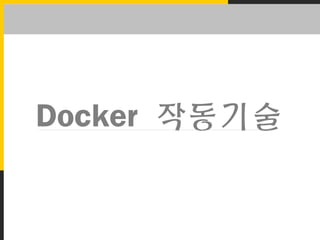
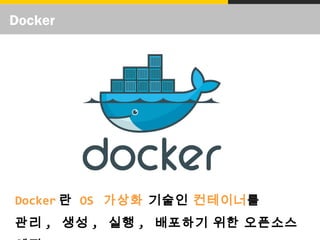

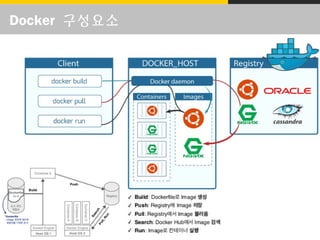
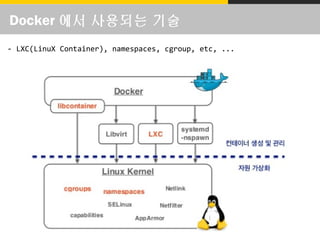
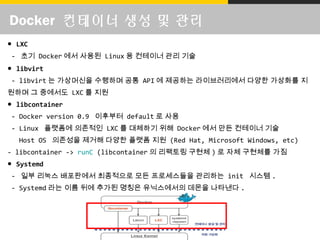
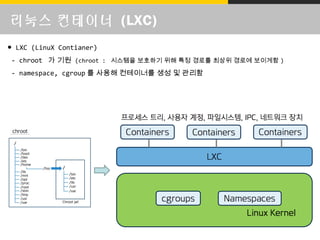
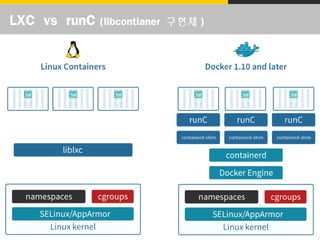

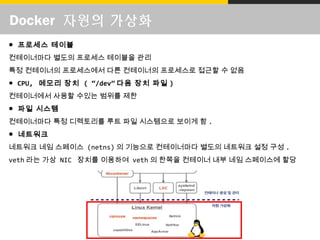

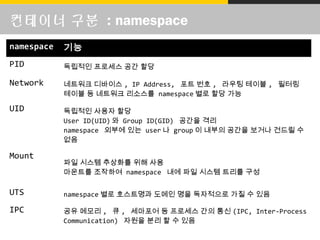

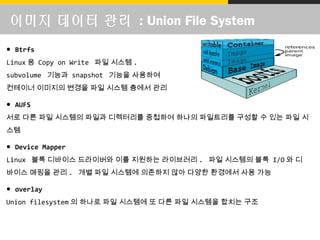
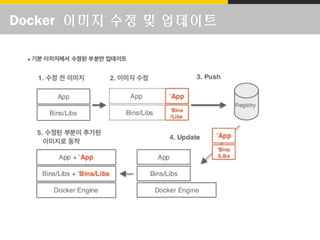
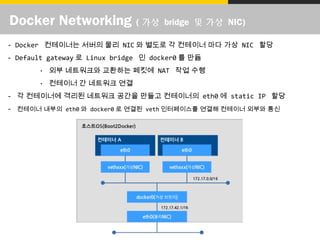
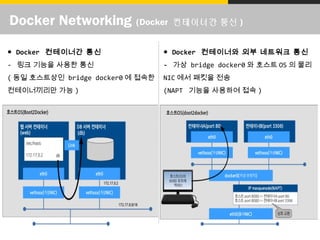
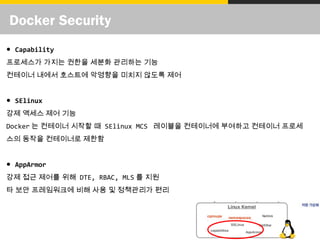
![ņ░ĖĻ│Āļ¦üĒü¼
ŌŚÅ [Docker] ņÖäļ▓ĮĒĢ£ IT ņØĖĒöäļØ╝ ĻĄ¼ņČĢņØä ņ£äĒĢ£ Docker: ņĀ£ 2 ņן ņ╗©ĒģīņØ┤ļäł Ļ░ĆņāüĒÖö ĻĖ░ņłĀĻ│╝ Docker ņÜöņĢĮ
http://miiingo.tistory.com/88?category=644188
ŌŚÅ Docker(container) ņØś ņ×æļÅÖ ņøÉļ”¼ : namespaces and cgroups
https://tech.ssut.me/2017/08/15/what-even-is-a-container/
ŌŚÅ what is Docker? ( Ļ░ĆņāüĒÖö , LXC, ņØ┤ļ»Ėņ¦Ć )
https://kbss27.github.io/2017/04/09/whydocker/
ŌŚÅ Docker Network ĻĄ¼ņĪ░ (1) - docker0 ņÖĆ container network ĻĄ¼ņĪ░
http://bluese05.tistory.com/15
ŌŚÅ Docker Container
/rkawkxms/docker-container
ŌŚÅ ļÅäņ╗ż ņĢäĒéżĒģŹņ│É ļ░Å ļÅÖņ×æņøÉļ”¼
http://gyus.me/?p=512
ŌŚÅ ļÅäņ╗ż ĻĘĖļ”¼Ļ│Ā Linux ņ╗©ĒģīņØ┤ļäł ĻĖ░ņłĀļōż
http://www.opennaru.com/openshift/docker/what-is-the-difference-between-docker-lxd-and-lxc/
ŌŚÅ ļÅäņ╗ż vs LXC ļ╣äĻĄÉ
http://wiki.rockplace.co.kr/pages/viewpage.action?pageId=3868344
ŌŚÅ What is Containerd ?
https://blog.docker.com/2017/08/what-is-containerd-runtime/
ŌŚÅ What is docker ?
https://indrabasak.wordpress.com/2017/04/03/what-is-docker/
ŌŚÅ Docker ņŚÉņä£ ņ¦ĆņøÉĒĢśļŖö Linux Kernel ņØś ĻĖ░ļŖź ( ņÜöņĢĮĒÄĖ ) ’āĀ ņØ╝ļ│Ėņé¼ņØ┤ĒŖĖ
http://blog.etsukata.com/2014/05/docker-linux-kernel.html
ŌŚÅ docker Ļ░Ć libcontianer ļź╝ ņŗ£ņ×æĒĢ£ ņØ┤ņ£Ā
https://www.zdnet.com/article/docker-libcontainer-unifies-linux-container-powers/
ŌŚÅ docker 0.9 : libcontianer ņŗżĒ¢ēļō£ļØ╝ņØ┤ļ▓ä ņåīĻ░£
https://blog.docker.com/2014/03/docker-0-9-introducing-execution-drivers-and-libcontainer/](https://image.slidesharecdn.com/dockerprinciple-180731133656/85/Backend-Master-3-4-5-Deploy-Docker-Principal-19-320.jpg)